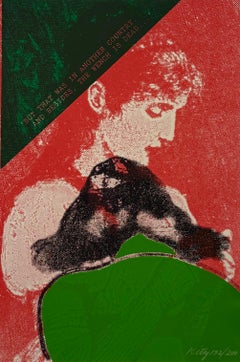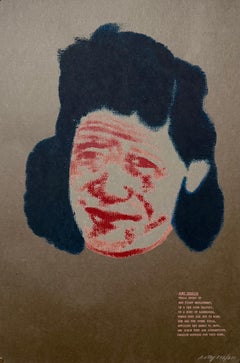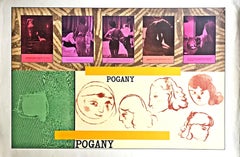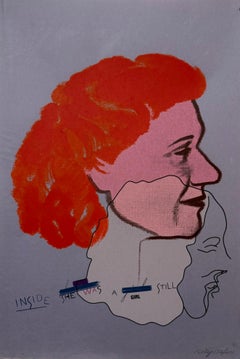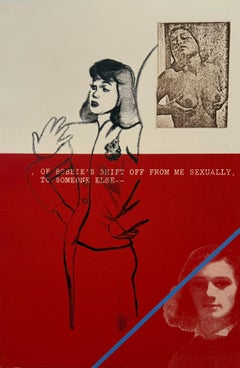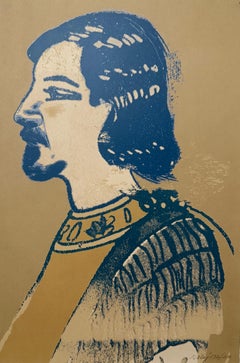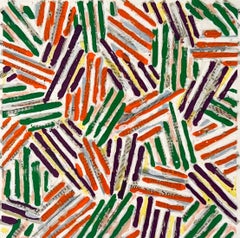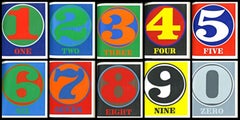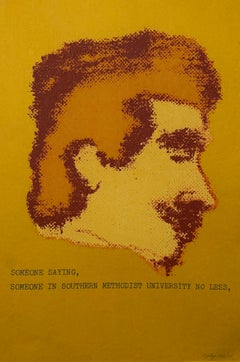Ronald Brooks Kitaj Abstract Prints
American, 1932-2007
Born in Cleveland, Ohio in 1932, R.B. (Ronald Brooks) Kitaj is considered a key figure in European and American contemporary painting. While his work has been considered controversial, he is regarded as a master draftsman with a commitment to figurative art. His highly personal paintings and drawings reflect his deep interest in history; cultural, social and political ideologies; and issues of identity.
Among his various honors are election to the American Academy of Arts and Letters in 1982, and election to the Royal Academy in 1985 (the first American since John Singer Sargent to receive this honor.)
Numerous retrospective exhibitions of his work include shows at the Hirshhorn Museum in Washington, D.C.; The Jewish Museum, Berlin; The Jewish Museum, London; and the Hamburger Kunsthalle in Germany.
Raised in Cleveland, Ohio, and Troy, New York, Kitaj joined the Merchant Marines in 1949.
In 1950, between sailings, he attended classes at the Cooper Union for the Advancement of Science and Art in New York. He went on to study drawing at the Academy of Fine Art in Vienna, Austria.
Kitaj moved to Oxford, England in 1957, and enrolled at The Ruskin School of Drawing and Fine Art, University of Oxford.
In 1959, Kitaj was accepted into Royal College of Art, London, where he befriended classmate David Hockney. Upon graduation from the RCA, Kitaj signed with Marlborough Fine Art, London, where he had his first solo exhibition in 1963. His art career began in earnest, and he found critical acclaim alongside commercial success.
A second solo show followed at Marlborough Gallery, New York, in 1965, and he sold “The Ohio Gang” to The Museum of Modern Art.
In 1969, Kitaj taught for a year at the University of California, Los Angeles.
In 1976, he coined the term “School of London” in an essay he wrote as curator of the polemical exhibition, “The Human Clay,” at the Hayward Gallery, London. The term, though loose, continues to define a group of stylistically diverse artists, including Kitaj, who were working in London at that time focusing on figural representation.
In 1981, he spent a year in Paris, France, where he focused on drawing and use of pastel.
In 1994, the Tate Gallery, London, organized a major retrospective of Kitaj’s work. Hostile and personal attacks from some critics led to what Kitaj referred to as the “Tate War.” The exhibition subsequently traveled to the Los Angeles County Museum of Art and the Metropolitan Museum of Art, New York.
Kitaj moved to Los Angeles, California, and continued to exhibit with Marlborough Fine Art and the Marlborough Gallery, New York.
In 2001 the National Gallery London organized a solo exhibition of paintings: “R.B. Kitaj In the Aura of Cezanne and Other Masters.” Kitaj focused on his “late style” in his Yellow Studio in Westwood and died in 2007.
His gift of his archive to the UCLA Library Special Collections was celebrated with exhibitions at the Skirball Cultural Center and UCLA’s Young Research Library.to
1
17
1
Overall Width
to
Overall Height
to
19
40
668
211
165
159
19
1
18
18
1
19
1
19
Artist: Ronald Brooks Kitaj
British Pop Art Artist RB Kitaj Screenprint Day Book Serigraph Silkscreen Signed
By Ronald Brooks Kitaj
Located in Surfside, FL
R.B. Kitaj (British American 1932-2007)
Hand signed and numbered
Screenprint
Measures approximately 24.5 X 16.65 inches
This is from the Robert Creeley daybook. They were done in ...
Category
1970s Pop Art Ronald Brooks Kitaj Abstract Prints
Materials
Screen
British Pop Art Artist RB Kitaj Screenprint Day Book Serigraph Silkscreen Signed
By Ronald Brooks Kitaj
Located in Surfside, FL
R.B. Kitaj (British American 1932-2007)
Hand signed and numbered
Screenprint
Measures approximately 24.5 X 16.65 inches
This is from the Robert Creeley daybook. They were done in ...
Category
1970s Pop Art Ronald Brooks Kitaj Abstract Prints
Materials
Screen
POGANY rare 17 color 1960s British Pop silkscreen signed numbered edition of 70
By Ronald Brooks Kitaj
Located in New York, NY
R.B. Kitaj
POGANY, 1966
17 colour Screenprint and Photo-screenprint
24 × 36 inches
Pencil signed and numbered from the Limited Edition of 70
Hand-signed by artist, Signed & numbered ...
Category
1960s Pop Art Ronald Brooks Kitaj Abstract Prints
Materials
Screen, Pencil
British Pop Art Artist RB Kitaj Screenprint Day Book Serigraph Silkscreen Signed
By Ronald Brooks Kitaj
Located in Surfside, FL
R.B. Kitaj (British American 1932-2007)
Hand signed and numbered
Screenprint
This is from the Robert Creeley daybook. They were done in a variety of mixed media including serigraph, ...
Category
1970s Pop Art Ronald Brooks Kitaj Abstract Prints
Materials
Screen
British Pop Art Artist RB Kitaj Screenprint Day Book Serigraph Silkscreen Signed
By Ronald Brooks Kitaj
Located in Surfside, FL
R.B. Kitaj (British American 1932-2007)
Hand signed and numbered
Screenprint
This is from the Robert Creeley daybook. They were done in a variety of mixed media including serigraph, ...
Category
1970s Pop Art Ronald Brooks Kitaj Abstract Prints
Materials
Screen
British Pop Art Artist RB Kitaj Screenprint Day Book Serigraph Silkscreen Signed
By Ronald Brooks Kitaj
Located in Surfside, FL
R.B. Kitaj (British American 1932-2007)
Hand signed and numbered
Screenprint
This is from the Robert Creeley daybook. They were done in a variety of mixed media including serigraph, ...
Category
1970s Pop Art Ronald Brooks Kitaj Abstract Prints
Materials
Screen
British Pop Art Artist RB Kitaj Screen Print on Acetate Serigraph Signed
By Ronald Brooks Kitaj
Located in Surfside, FL
R.B. Kitaj (British American 1932-2007)
Hand signed and numbered
Screenprint
Measures approximately 24.5 X 16.65 inches
This is from the Robert Creeley daybook. They were done in ...
Category
1970s Pop Art Ronald Brooks Kitaj Abstract Prints
Materials
Screen
BAGHDAD Six color screenprint, renowned British Pop pioneer R.B. Kitaj, Signed/N
By Ronald Brooks Kitaj
Located in New York, NY
Ronald Brooks (R.B.) Kitaj
BAGHDAD, 1972
Six Color Screenprint and Photoscreenprint
20 × 14 1/2 inches
Pencil signed and numbered 1/125
Printed at Kelpra Studio, London
Published by ...
Category
1970s Pop Art Ronald Brooks Kitaj Abstract Prints
Materials
Screen
British Pop Art Artist RB Kitaj Screenprint Day Book Serigraph Silkscreen Signed
By Ronald Brooks Kitaj
Located in Surfside, FL
R.B. Kitaj (British American 1932-2007)
Hand signed and numbered
Screenprint
Measures approximately 24.5 X 16.65 inches
This is from the Robert Creeley daybook. They were done in ...
Category
1970s Pop Art Ronald Brooks Kitaj Abstract Prints
Materials
Screen
British Pop Art Artist RB Kitaj Screenprint Day Book Serigraph Silkscreen Signed
By Ronald Brooks Kitaj
Located in Surfside, FL
R.B. Kitaj (British American 1932-2007)
Hand signed and numbered
Screenprint
Measures approximately 24.5 X 16.65 inches
This is from the Robert Creeley daybook. They were done in ...
Category
1970s Pop Art Ronald Brooks Kitaj Abstract Prints
Materials
Screen
British Pop Art Artist RB Kitaj Screenprint Day Book Serigraph Silkscreen Signed
By Ronald Brooks Kitaj
Located in Surfside, FL
R.B. Kitaj (British American 1932-2007)
Hand signed and numbered
Screenprint
Measures approximately 24.5 X 16.65 inches
This is from the Robert Creeley daybook. They were done in ...
Category
1970s Pop Art Ronald Brooks Kitaj Abstract Prints
Materials
Screen
British Pop Art Artist RB Kitaj Day Book Mourlot Lithograph Jim Dine Signed
By Ronald Brooks Kitaj
Located in Surfside, FL
R.B. Kitaj (British American 1932-2007)
Hand signed and numbered
Screenprint
This is from the Robert Creeley daybook. They were done in a variety of mixed media including serigraph, ...
Category
1970s Pop Art Ronald Brooks Kitaj Abstract Prints
Materials
Screen
British Pop Art Artist RB Kitaj Screenprint Day Book Serigraph Hand Signed
By Ronald Brooks Kitaj
Located in Surfside, FL
R.B. Kitaj (British American 1932-2007)
Hand signed and numbered
Screenprint
Measures approximately 24.5 X 16.65 inches
This is from the Robert Creeley daybook. They were done in a...
Category
1970s Pop Art Ronald Brooks Kitaj Abstract Prints
Materials
Screen
British Pop Art Artist RB Kitaj Screenprint Day Book Serigraph Silkscreen Signed
By Ronald Brooks Kitaj
Located in Surfside, FL
R.B. Kitaj (British American 1932-2007)
Hand signed and numbered
Screenprint
This is from the Robert Creeley daybook. They were done in a variety of mixed media including serigraph, ...
Category
1970s Pop Art Ronald Brooks Kitaj Abstract Prints
Materials
Screen
British Pop Art Artist RB Kitaj Screenprint Day Book Serigraph Silkscreen Signed
By Ronald Brooks Kitaj
Located in Surfside, FL
R.B. Kitaj (British American 1932-2007)
Hand signed and numbered
Screenprint
Measures approximately 24.5 X 16.65 inches
This is from the Robert Creeley daybook. They were done in ...
Category
1970s Pop Art Ronald Brooks Kitaj Abstract Prints
Materials
Screen
British Pop Art Artist RB Kitaj Screenprint Day Book Serigraph Silkscreen Signed
By Ronald Brooks Kitaj
Located in Surfside, FL
R.B. Kitaj (British American 1932-2007)
Hand signed and numbered
Screenprint
Measures approximately 24.5 X 16.65 inches
This is from the Robert Creeley daybook. They were done in ...
Category
1970s Pop Art Ronald Brooks Kitaj Abstract Prints
Materials
Screen
British Pop Art Artist RB Kitaj Screenprint Day Book Serigraph Silkscreen Signed
By Ronald Brooks Kitaj
Located in Surfside, FL
R.B. Kitaj (British American 1932-2007)
Hand signed and numbered
Screenprint
This is from the Robert Creeley daybook. They were done in a variety of mixed media including serigraph, ...
Category
1970s Pop Art Ronald Brooks Kitaj Abstract Prints
Materials
Screen
British Pop Art Artist RB Kitaj Screenprint Day Book Serigraph Silkscreen Signed
By Ronald Brooks Kitaj
Located in Surfside, FL
R.B. Kitaj (British American 1932-2007)
Hand signed and numbered
Screenprint
Measures approximately 24.5 X 16.65 inches
This is from the Robert Creeley daybook. They were done in ...
Category
1970s Pop Art Ronald Brooks Kitaj Abstract Prints
Materials
Screen
British Pop Art Artist RB Kitaj Screenprint Day Book Serigraph Hand Signed
By Ronald Brooks Kitaj
Located in Surfside, FL
R.B. Kitaj (British American 1932-2007)
Hand signed and numbered
Screenprint
Measures approximately 24.5 X 16.65 inches
This is from the Robert Creeley daybook. They were done in a ...
Category
1970s Pop Art Ronald Brooks Kitaj Abstract Prints
Materials
Screen
Related Items
Jasper Johns Untitled
By Jasper Johns
Located in Washington, DC
Artist: Jasper Johns
Title: Untitled
Medium: Screenprint in colors on Patapar printing parchment
Year: 1977
Edition: 3000
Frame Size: 18 1/2" x 18 1/2"
Sheet Size: 10 5/8" x 10 1/4"
...
Category
1970s Pop Art Ronald Brooks Kitaj Abstract Prints
Materials
Screen
Numbers: Complete Portfolio of 10 Color Silkscreens, Hand Signed on 1st End page
By Robert Indiana
Located in New York, NY
Robert Indiana
Numbers: Complete Portfolio of 10 Color Silkscreens (Sheehan 46-55) bound in cloth slip case (Hand Signed, inscribed and dated by Robert Indiana on the first front end...
Category
1960s Pop Art Ronald Brooks Kitaj Abstract Prints
Materials
Board, Screen
Sister Corita Kent, Yes to You silkscreen, Hand Signed Artists Proof with heart
By Corita Kent
Located in New York, NY
Corita Kent
Yes to You, 1979
Color silkscreen
Hand signed, numbered and uniquely inscribed with a heart doodle by the artist on the front.
Artists Proof (aside from the regular editi...
Category
1970s Pop Art Ronald Brooks Kitaj Abstract Prints
Materials
Screen
$2,800
H 11.75 in W 11.75 in D 1.5 in
Global Warning - Global Warming (Andy Warhol museum Edition) - Signed/N politics
By Shepard Fairey
Located in New York, NY
SHEPARD FAIREY
Global Warning - Global Warming (Andy Warhol Edition), 2009
Silkscreen on wove paper
24 × 18 inches
Pencil signed and numbered 264/450 on the front
Unframed
Global War...
Category
Early 2000s Pop Art Ronald Brooks Kitaj Abstract Prints
Materials
Screen
Deluxe Signed Edition of Film Festival Lincoln Center (Feldman & Schellmann, II)
By Andy Warhol
Located in New York, NY
Andy Warhol
Deluxe Signed Edition of Film Festival Lincoln Center (Feldman & Schellmann, II.19), 1967
Silkscreen, die-cut on opaque acrylic
Edition 2/200 (Signed and numbered on the back with engraving pen)
Hand-signed by artist, As this work was done on acrylic, Warhol signed and numbered it by hand on verso with an engraving needle. Printed date with copyright
Frame included: Elegantly framed in a museum quality wood frame with UV plexiglass. A die-cut window has been created in the back of the frame to reveal Warhol's incised signature and edition
Publisher: Leo Castelli, New York
Printer: Chiron Press, New York
Catalogue Raisonne: Feldman & Schellmann, II.19
This work is often hung and displayed both vertically and horizontally - see photos for inspiration
This work is one of only 200 done on opaque acrylic rather than wove paper, signed and numbered on the opaque acrylic by Andy Warhol with an engraving pen. (Separately, there was an unsigned edition of 500 on wove paper). What distinguishes this rare, extremely desirable signed edition of 200, other than that it is signed and numbered by hand by Andy Warhol, is that the black graphic text FIFTH NEW YORK is placed directly over the text Film Festival of Lincoln Center; whereas in the edition of 500, the text black text FIFTH NEW YORK is placed on top of the white text. An innovative feature that appears in this special edition is a perforated line running across the surface of the print, at its triangular cut out sides, mimicking the tear line present in real commercial movie admissions tickets. Chiron Press commissioned by Lincoln Center, devised a special process expressly to imprint the edition with this perforation using a die cut stamp. This work is quintessential early Warhol, with characteristic bright neon colors, featuring text, along with the artist's very recognizable flower motif. The Lincoln Center ticket...
Category
1960s Pop Art Ronald Brooks Kitaj Abstract Prints
Materials
Plastic, Mixed Media, Screen
$50,000
H 49 in W 29 in D 1.75 in
Joe Tilson British Pop Art Screenprint, Color Lithograph 4 Seasons 4 Elements
By Joe Tilson
Located in Surfside, FL
Silkscreen screenprint or Lithograph
Hand signed and numbered. An esoteric, mystical, Kabbala inspired print with Hebrew as well as other languages.
Joseph Charles Tilson RA (born 2...
Category
1970s Pop Art Ronald Brooks Kitaj Abstract Prints
Materials
Screen, Lithograph
Hope - Progress, Pop Art Screenprint Diptych by Steven Gagnon
By Steven Gagnon
Located in Long Island City, NY
Two silkscreen prints by Steven Gagnon from 2011. Political commentary in pop art style imagery with a farcical tone. Unframed, hand signed in lower right corner.
Artist: Steven Ga...
Category
20th Century Pop Art Ronald Brooks Kitaj Abstract Prints
Materials
Screen
$5,000
H 29.5 in W 26 in
Peter Blake 110 Years of Vauxhall, Pop tribute to Art Car, British flag signed/n
By Peter Blake
Located in New York, NY
Peter Blake
110 Years of Vauxhall, 2013
Silkscreen on Linen
Hand signed and numbered 80/110 by the artist on the front
9 × 17 inches
Unframed
Sir Peter Blake is one of the most successful British Pop artists from the fabulous 1960s, and his work can be found in major museums and collections worldwide. He is best known for creating the sleeve design of the Beatles' album Sgt. Pepper's Lonely Hearts Club Band. It was with the Young Contemporaries exhibition of 1961, where he exhibited alongside David Hockney and R.B. Kitaj, that Blake rose to prominence. Blake created this limited edition print, a tribute to the Art Car, exclusively for the Vauxhall Art Car Boot Fair 2013. The work sold out completely in less than 15 minutes. It is in excellent condition. Pencil signed and numbered from the limited edition of only 110. The excitement of the event was described in a British news report as follows: "Now in its 100th year, the fair it featured work by over 70 renowned artists including Sir Peter Blake, Gavin Turk, Emin International, Polly Morgan, Mat Collishaw...
Category
2010s Pop Art Ronald Brooks Kitaj Abstract Prints
Materials
Linen, Screen
Jasper Johns, Target with Four Faces (ULAE 55), iconic 1960s Pop Art silkscreen
By Jasper Johns
Located in New York, NY
Jasper Johns
Target with Four Faces (ULAE 55), 1968
Silkscreen in colors on Rives BFK wove paper
Signed and dated in red ink and numbered 53/100 (total edition includes ten artist's ...
Category
1960s Pop Art Ronald Brooks Kitaj Abstract Prints
Materials
Screen
$70,000
H 46.5 in W 35 in D 2 in
IDENTITY CRISIS (WHITE)
By Ronnie Cutrone
Located in Aventura, FL
Screen print in colors on paper. Hand signed and numbered by Ronnie Cutrone. From the edition of 150.
Certificate of Authenticity included. Please do not hesitate to ask us any further questions. All reasonable offers will be considered.
Please note our gallery has more than 1 of this artwork in stock and the exact edition number you may receive may be different than pictured.
About the artist: Ronnie Cutrone (American, b.1948) is a Pop artist renowned for his vibrant, satirical paintings...
Category
1980s Pop Art Ronald Brooks Kitaj Abstract Prints
Materials
Screen, Paper
VOTE limited edition political silkscreen, Signed/N with five basketballs Pop Ar
By Jonas Wood
Located in New York, NY
Jonas Wood
VOTE, 2018
6-color screenprint on Coventry rag paper
Hand signed, dated and numbered from the limited edition of 300 by Jonas Wood on the front
20 3/10 × 14 3/5 inches
Unf...
Category
2010s Pop Art Ronald Brooks Kitaj Abstract Prints
Materials
Screen
$2,500
H 20.3 in W 14.4 in
Judy Rifka Abstract Expressionist Contemporary Lithograph Hebrew 10 Commandment
By Judy Rifka
Located in Surfside, FL
Judy Rifka (American, b. 1945)
44/84 Lithograph on paper titled "Thou Shalt Not Bear False Witness against Thy Neighbor"; Depicting an abstract composition in blue, green, red and black tones with Hebrew script. Judaica interest. (I have seen this print described as a screenprint and as a lithograph)
Hand signed in pencil and dated alongside an embossed pictorial blindstamp of a closed hand with one raised index finger. Solo Press.
From The Ten Commandments Kenny Scharf; Joseph Nechvatal; Gretchen Bender; April Gornik; Robert Kushner; Nancy Spero; Vito Acconci; Jane Dickson; Judy Rifka; Richard Bosman and Lisa Liebmann.
Judy Rifka (born 1945) is an American woman artist active since the 1970s as a painter and video artist. She works heavily in New York City's Tribeca and Lower East Side and has associated with movements coming out of the area in the 1970s and 1980s such as Colab and the East Village, Manhattan art scene. A video artist, book artist and abstract painter, Rifka is a multi-faceted artist who has worked in a variety of media in addition to her painting and printmaking. She was born in 1945 in New York City and studied art at Hunter College, the New York Studio School and the Skowhegan School of Painting and Sculpture in Maine.
Rifka took part in the 1980 Times Square Show, (Organized by Collaborative Projects, Inc. in 1980 at what was once a massage parlor, with now-famous participants such as Jenny Holzer, Nan Goldin, Keith Haring, Kenny Scharf, Jean-Michel Basquiat, and Kiki Smith, the roster of the exhibition reads like a who’s who of the art world), two Whitney Museum Biennials (1975, 1983), Documenta 7, Just Another Asshole (1981), curated by Carlo McCormick and received the cover of Art in America in 1984 for her series, "Architecture," which employed the three-dimensional stretchers that she adopted in exhibitions dating to 1982; in a 1985 review in the New York Times, Vivien Raynor noted Rifka's shift to large paintings of the female nude, which also employed the three-dimensional stretchers. In a 1985 episode of Miami Vice, Bianca Jagger played a character attacked in front of Rifka's three-dimensional nude still-life, "Bacchanaal", which was on display at the Museum of Art Fort Lauderdale. Rene Ricard wrote about Rifka in his influential December 1987 Art Forum article about the iconic identity of artists from Van Gogh to Jean-Michel Basquiat and Keith Haring, The Radiant Child.The untitled acrylic painting on plywood, in the collection of the Honolulu Museum of Art, demonstrates the artist's use of plywood as a substrate for painting. Artist and writer Mark Bloch called her work "imaginative surfaces that support experimental laboratories for interferences in sensuous pigment." According to artist and curator Greg de la Haba, Judy Rifka's irregular polygons on plywood "are among the most important paintings of the decade".
In 2013, Rifka's daily posts on Facebook garnered a large social media audience for her imaginative "selfies," erudite friendly comments, and widely attended solo and group exhibitions, Judy Rifka's pop art figuration is noted for its nervous line and frenetic pace. In the January 1998 issue of Art in America, Vincent Carducci echoed Masheck, “Rifka reworks the neo-classical and the pop, setting all sources in quotation for today’s art-world cognoscenti.” Rifka, along with artists like David Wojnarowicz, helped to take Pop sensibility into a milieu that incorporated politics and high art into Postmodernism; Robert Pincus-Witten stated in his 1988 essay, Corinthian Crackerjacks & Passing Go that "Rifka’s commitment to process and discovery, doctrine with Abstract Expressionist practice, is of paramount concern though there is nothing dogmatic or pious about Rifka’s use of method. Playful rapidity and delight in discovery is everywhere evident in her painting." In 2016, a large retrospective of Rifka's art was shown at the Jean-Paul Najar Foundation in Dubai. In 2017, Gregory de la Haba presented a Rifka retrospective at the Amstel Gallery in The Yard, a section of Manhattan described as "a labyrinth of small cubicles, conference rooms and small office spaces that are rented out to young entrepreneurs, professionals and hipsters". In 2019 her video Bubble Dancers New Space Ritual was selected for the International Istanbul Bienali.
Alexandra Goldman Talks To Judy Rifka About Ionic Ironic: Mythos from the '80s at CORE:Club and the Inexistence of "Feminist Art" Whitehot Magazine of Contemporary Art. She was included in "50 Contemporary Women Artists", a book comprising a refined selection of current and impactful artists. The foreword is by Elizabeth Sackler of the Brooklyn Museum’s Sackler Center for Feminist Art. Additional names in the book include sculptor and carver Barbara Segal...
Category
1980s Pop Art Ronald Brooks Kitaj Abstract Prints
Materials
Lithograph, Screen
Previously Available Items
British Pop Art Artist RB Kitaj Screenprint Day Book Serigraph Silkscreen Signed
By Ronald Brooks Kitaj
Located in Surfside, FL
R.B. Kitaj (British American 1932-2007)
Hand signed and numbered
Screenprint
Measures approximately 24.5 X 16.65 inches
This is from the Robert Creeley daybook. They were done in ...
Category
1970s Pop Art Ronald Brooks Kitaj Abstract Prints
Materials
Screen
In Our Time - China of Today, Art Deco Screenprint by Ronald Brooks Kitaj
By Ronald Brooks Kitaj
Located in Long Island City, NY
Artist: R. B. Kitaj, American (1932 - 2007)
Title: In Our Time - China of Today
Year: 1970
Medium: Screenprint, signed 'RK' in pencil
Edition: 150
Image Size: 18 x 23 inches
Size: 22...
Category
1970s Conceptual Ronald Brooks Kitaj Abstract Prints
Materials
Screen
Ronald Brooks Kitaj abstract prints for sale on 1stDibs.
Find a wide variety of authentic Ronald Brooks Kitaj abstract prints available for sale on 1stDibs. You can also browse by medium to find art by Ronald Brooks Kitaj in screen print and more. Much of the original work by this artist or collective was created during the 20th century and is mostly associated with the Pop Art style. Not every interior allows for large Ronald Brooks Kitaj abstract prints, so small editions measuring 15 inches across are available. Customers who are interested in this artist might also find the work of Ronnie Cutrone, Bob Pardo, and Robin Morris. Ronald Brooks Kitaj abstract prints prices can differ depending upon medium, time period and other attributes. On 1stDibs, the price for these items starts at $700 and tops out at $1,500, while the average work can sell for $1,450.
